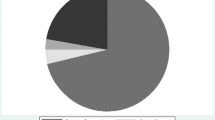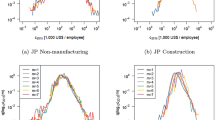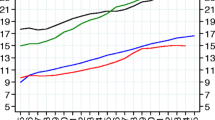Abstract
Labor economists have suggested that employee earnings may be relatively higher in firms possessing market power, such as that which may stem from government regula-tion of prices or entry of firms. We test this hypothesis, which previously has been inves-tigated in the context of industries such as trucking and air transportation, using earnings data for the cable television industry. Our empirical findings suggest that cable TV employees capture some of the benefits producers receive from regulations restricting competition.
Similar content being viewed by others
References
Ashenfelter, Orley and George Johnson. “Unionism, Relative Wages, and Labor Quality in U.S. Manufacturing Industries.ℍ International Economic Review 13 (October 1972): 488–507.
Beil, Richard O., Jr., Thomas P. Dazzio, Jr., Robert B. Ekelund, Jr., and John D. Jackson. “Competition and the Price of Municipal Cable Television Services: An Empirical Study.ℍ Journal of Regulatory Economics 6 (1993): 401–15.
Boudreaux, Donald J. and Robert B. Ekelund, Jr. “Cable Regulation.ℍ Cato Journal 14 (Spring/Summer 1994): 87–107.
Brown, Charles and James Medoff. “The Employer-Size Wage Effect.ℍ Journal of Political Economy 97 (October 1989): 1027–59.
Dalton, James A. and Edward J. Ford, Jr. “Concentration and Labor Earnings in Manufacturing and Utilities.ℍ Industrial and Labor Relations Review 31 (October 1977): 45–59.
Ehrenberg, Ronald G. The Regulatory Process and Labor Earnings. New York: Academic Press, 1979.
— and Robert S. Smith. Modern Labor Economics: Theory and Public Policy. Reading, Mass.: Addison-Wesley, 1996.
Haworth, Charles T. and David W. Rasmussen. “Human Capital and Inter-Industry Wages in Manufacturing.ℍ Review of Economics and Statistics 51 (August 1969): 341–45.
Haworth, Charles T. and Carol J. Reuther. “Industrial Concentration and Inter-Industry Wage Determination.ℍ Review of Economics and Statistics 60 (February 1978): 85–95.
Hendricks, Wallace. “Deregulation and Labor Earnings.ℍ Journal of Labor Research 15 (Summer 1994): 207–34.
—. “Regulation and Labor Earnings.ℍ Bell Journal of Economics 8 (Autumn 1977): 483–96.
Heywood, John S. “Labor Quality and the Concentration-Earnings Hypothesis.ℍ Review of Economics and Statistics 68 (May 1986): 342–46.
Hirsch, Barry T. “Trucking Regulation Unionization and Labor Earnings: 1973-85.ℍ Journal of Human Resources 23 (Summer 1988): 296–319.
Levin, Standord L. and John B. Meisel. “Cable Television and Competition: Theory, Evidence, and Policy.ℍ Telecommunications Policy (December 1991): 519-28.
Long, James E. and Albert N. Link. “The Impact of Market Structure on Wages, Fringe Benefits, and Turnover.ℍ Industrial and Labor Relations Review 36 (January 1983): 239–50.
Masters, Stanley H. “Wages and Plant Size: An Interindustry Analysis.ℍ Review of Economics and Statistics 51 (August 1969): 341–45.
Mayo, John W. and Yasuji Otsuka. “Demand, Pricing, and Regulation: Evidence from the Cable TV Industry.ℍ Rand Journal of Economics 22 (Autumn 1991): 396–410.
Merline, John. “How to Get Better TV at Lower Prices.ℍ Consumers' Research 73 (May 1990): 10–17.
Moore, Thomas G. “The Beneficiaries of Trucking Regulation.ℍ Journal of Law and Economics 21 (October 1978): 327–44.
“Most Federal Price Controls on Cable TV to End March 31.ℍ Opelika-Auburn News, February 10, 1999.
Television Digest. Television and Cable Factbook: Cable. Vols. 56 and 61. Washington, D.C.: (1989, 1993).
U.S. Department of Commerce. 1992 Census of Transportation, Communications, and Utilities, Subject Series, Miscellaneous Subjects. Washington, D.C.: U.S. Department of Commerce, August 1996.
—. Statistical Abstract of the United States. Washington, D.C.: U.S. Government Printing Office, 1993.
U.S. Department of Labor. Employment and Wages Annual Averages 1992 and 1993. Bulletin 2449. Washington, D.C.: U.S. Department of Labor, October 1994.
Weiss, Leonard W. “Concentration and Labor Earnings.ℍ American Economic Review 56 (March 1966): 96–112.
Author information
Authors and Affiliations
Rights and permissions
About this article
Cite this article
Crofton, S., Laband, D. & Long, J. Regulation, market power, and labor earnings: Evidence from the cable television industry. J Labor Res 21, 669–675 (2000). https://doi.org/10.1007/s12122-000-1039-7
Issue Date:
DOI: https://doi.org/10.1007/s12122-000-1039-7




